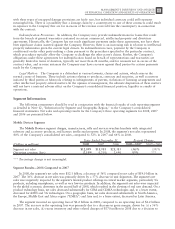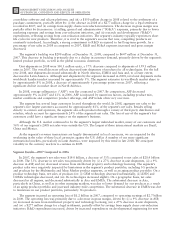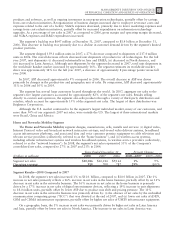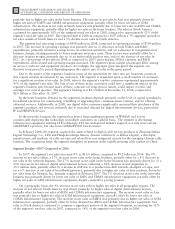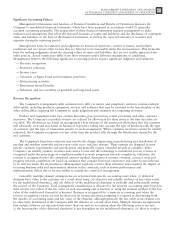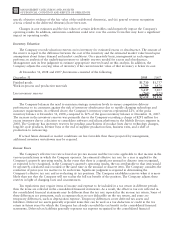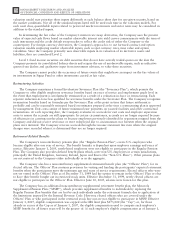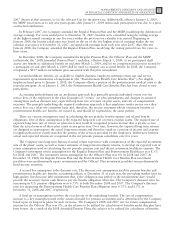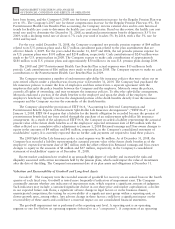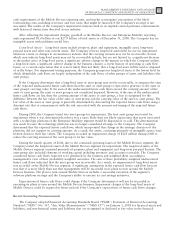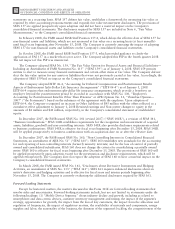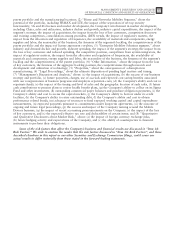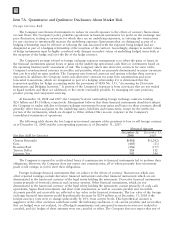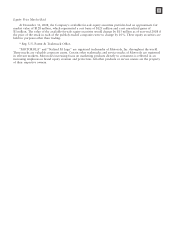Motorola 2008 Annual Report Download - page 79
Download and view the complete annual report
Please find page 79 of the 2008 Motorola annual report below. You can navigate through the pages in the report by either clicking on the pages listed below, or by using the keyword search tool below to find specific information within the annual report.
2007 (frozen at that amount), or (ii) the relevant Cap for the given year. Additionally, effective January 1, 2009,
the MSPP was frozen as to any new participants after January 1, 2009 unless such participation was due to a prior
contractual entitlement.
In February 2007, the Company amended the Regular Pension Plan and the MSPP, modifying the definition of
average earnings. For years ended prior to December 31, 2007, benefits were calculated using the rolling average
of the highest annual earnings in any five years within the previous ten calendar year period. Beginning in
January 2008, the benefit calculation was based on the set of the five highest years of earnings within the ten
calendar years prior to December 31, 2007, averaged with earnings from each year after 2007. Also effective
January 2008, the Company amended the Regular Pension Plan, modifying the vesting period from five years to
three years.
In December 2008, the Company amended the Regular Pension Plan, the Officers’ Plan and the MSPP
(collectively, the “2008 Amended Pension Plans”) such that, effective March 1, 2009: (i) no participant shall
accrue any benefit or additional benefit on and after March 1, 2009, and (ii) no compensation increases earned by
a participant on and after March 1, 2009 shall be used to compute any accrued benefit. In 2008, the Company
recognized a $237 million curtailment gain associated with this plan amendment.
Certain healthcare benefits are available to eligible domestic employees meeting certain age and service
requirements upon termination of employment (the “Postretirement Health Care Benefits Plan”). For eligible
employees hired prior to January 1, 2002, the Company offsets a portion of the postretirement medical costs to the
retired participant. As of January 1, 2005, the Postretirement Health Care Benefits Plan has been closed to new
participants.
Accounting methodologies use an attribution approach that generally spreads individual events over the
service lives of the employees in the plan. Examples of “events” are plan amendments and changes in actuarial
assumptions such as discount rate, expected long-term rate of return on plan assets, and rate of compensation
increases. The principle underlying the required attribution approach is that employees render service over their
service lives on a relatively consistent basis and, therefore, the income statement effects of pension benefits or
postretirement health care benefits are earned in, and should be expensed in, the same pattern.
There are various assumptions used in calculating the net periodic benefit expense and related benefit
obligations. One of these assumptions is the expected long-term rate of return on plan assets. The required use of
expected long-term rate of return on plan assets may result in recognized pension income that is greater or less
than the actual returns of those plan assets in any given year. Over time, however, the expected long-term returns
are designed to approximate the actual long-term returns and therefore result in a pattern of income and expense
recognition that more closely matches the pattern of the services provided by the employees. Differences between
actual and expected returns are recognized in the net periodic pension calculation over five years.
The Company uses long-term historical actual return experience with consideration of the expected investment
mix of the plans’ assets, as well as future estimates of long-term investment returns, to develop its expected rate of
return assumption used in calculating the net periodic pension cost and the net retirement healthcare expense. The
Company’s investment return assumption for the Regular Pension Plan and Postretirement Healthcare was 8.5%
for 2008 and 2007. The investment return assumption for the Officers’ Plan was 6% in 2008 and 2007. At
December 31, 2008, the Regular Pension Plan and the Postretirement Health Care Benefits Plan investment
portfolios were predominantly equity investments and the Officers’ Plan investment portfolio was predominantly
fixed-income securities.
A second key assumption is the discount rate. The discount rate assumptions used for pension benefits and
postretirement health care benefits accounting reflects, at December 31 of each year, the prevailing market rates for
high-quality, fixed-income debt instruments that, if the obligation was settled at the measurement date, would
provide the necessary future cash flows to pay the benefit obligation when due. The Company’s discount rates for
measuring its U.S. pension obligations were 6.75% at both December 2008 and 2007. The Company’s discount
rates for measuring the Postretirement Health Care Benefits Plan obligation were 6.75% and 6.5% at
December 31, 2008 and 2007, respectively.
A final set of assumptions involves the cost drivers of the underlying benefits. The rate of compensation
increase is a key assumption used in the actuarial model for pension accounting and is determined by the Company
based upon its long-term plans for such increases. The Company’s 2008 and 2007 rate for future compensation
increase for the Officers’ Plan was 0%, as the salaries to be utilized for calculation of benefits under this plan have
been frozen. As a result of the 2008 Amended Pension Plans, the salaries to be utilized for calculation of benefits
71
MANAGEMENT’S DISCUSSION AND ANALYSIS
OF FINANCIAL CONDITION AND RESULTS OF OPERATIONS


